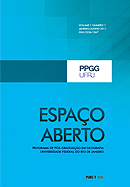Intervenção: Geografia Física Crítica / Intervention: Critical Physical Geography
DOI:
https://doi.org/10.36403/espacoaberto.2019.25397Palavras-chave:
Geografia Física, Geografia Humana Crítica, Transdisciplinaridade, Antropoceno.Resumo
Um artigo de opinião, recentemente publicado, reacendeu o debate sobre se a composição interdisciplinar que atualmente existe na área da Geografia é um vestígio da história ou uma atual e potencial fonte de vitalidade intelectual. Neste artigo nós adotamos esta última postura e destacamos os benefícios da integração prolongada da Geografia Física e Geografia Humana crítica. Por razões políticas e pragmáticas, nós denominamos esta área de pesquisa e prática indissociáveis de Geografia Física Crítica (GFC). A GFC combina a atenção crítica às relações de poder com o conhecimento profundo das ciências biofísicas ou tecnológicas a serviço da transformação social e ambiental. Argumentamos que a pesquisa da GFC, quando realizada por indivíduos ou equipes, podem melhorar a qualidade intelectual e expandir a relevância política da Geografia Física e da Humana críticas, dado que é cada vez mais impraticável analisar sistemas naturais e sociais separadamente: as paisagens sociobiofísicas são tanto produto de relações desiguais de poder, do legado histórico do colonialismo e das disparidades raciais e de gênero, quanto de fatores físicos como a hidrologia, ecologia e alterações climáticas. Neste texto, nós apresentamos os trabalhos existentes em GFC, discutimos os principais benefícios de um engajamento crítico integrador na pesquisa, no ensino e na extensão; e oferecemos nossas reflexões coletivas sobre como fazer uma GFC viável.Downloads
Não há dados estatísticos.
Downloads
Publicado
2019-05-14
Como Citar
LAVE, Rebecca; WILSON, Matthew W.; BARRON, Elizabeth S. Intervenção: Geografia Física Crítica / Intervention: Critical Physical Geography. Espaço Aberto, Rio de Janeiro, Brasil, v. 9, n. 1, p. 77–94, 2019. DOI: 10.36403/espacoaberto.2019.25397. Disponível em: https://revistas.ufrj.br/index.php/EspacoAberto/article/view/25397. Acesso em: 20 dez. 2025.
Edição
Seção
Artigos
Licença
Os Direitos Autorais dos artigos publicados na revista Espaço Aberto pertencem ao(s) seu(s) respectivo(s) autor(es), com os direitos de primeira publicação cedidos à Revista. Toda vez que um artigo for citado, replicado em repositórios institucionais e/ou páginas pessoais ou profissionais, deve-se apresentar um link para o artigo disponível no site da revista. Os trabalhos estão simultaneamente licenciados sob a Licença Creative Commons BY-NC-SA 4.0.


